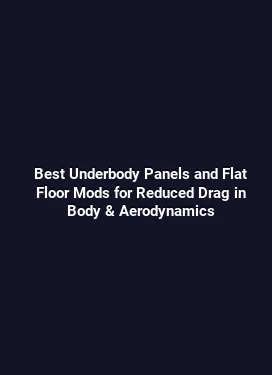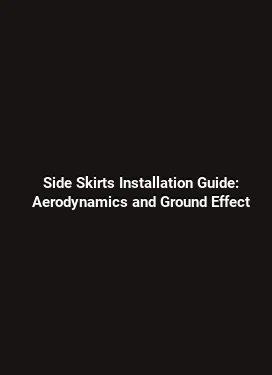Carbon Fiber Body Panels Weight Reduction Guide for Track Cars
In the pursuit of lower lap times and improved handling, track cars benefit from a holistic approach to weight reduction that preserves, or even enhances, structural integrity and aerodynamic performance. Carbon fiber body panels have emerged as a leading solution for teams and enthusiasts aiming to shed weight without compromising rigidity. This guide dives into the practical considerations, material science, and implementation strategies behind carbon fiber panels, with emphasis on how they affect overall vehicle dynamics on the track.
Understanding Weight Reduction Through Carbon Fiber Panels

Weight reduction in a track car is not merely about shedding kilograms; it is about preserving or improving the moment of inertia characteristics, chassis stiffness, and aerodynamic balance. Carbon fiber offers a favorable strength-to-weight ratio and tunable stiffness properties, which can translate into crisper steering response, improved tire contact with the track, and reduced unsprung weight when applied to appropriate components. When selecting panels, it is crucial to evaluate both the raw mass savings and the downstream effects on aerodynamics and suspension tuning.
Compared with traditional materials like aluminum or steel, carbon fiber panels can achieve significant weight reductions while offering customizable stiffness profiles. However, the real value comes from an integrated approach that considers how each panel interacts with the car’s overall aero package, cooling airflow, and load paths during high-G cornering and braking scenarios. The weight reduction targets should align with the car’s handling goals, whether that means sharper turn-in, reduced body roll, or more predictable brake dive characteristics.
Material Architecture: What Makes Carbon Fiber Panels Light and Strong
The core advantage of carbon fiber lies in its high specific strength and stiffness. The fibers provide excellent tensile properties, while the resin matrix binds the fibers and distributes loads. The orientation of fibers within a panel determines how the panel resists bending and torsional forces, which is critical for maintaining chassis geometry under dynamic track conditions. European and North American manufacturers increasingly employ multi-axial layups and tailored ply schedules to achieve the desired rigidity without unnecessary mass.
When evaluating panels, consider the following aspects: fiber type (pitch-based vs. pitch-oriented prepregs), weave architecture (twill, plain weave), layer count, and resin system. These variables influence not only weight and stiffness but also surface finish, impact resistance, and repairability. For track use, panels should be designed to absorb energy in the event of a light collision while preserving aerodynamic contours that contribute to downforce and flow attachment across the bodywork.
Panel Architecture and Structural Integration

Effective weight reduction begins with how panels integrate with the frame and adjacent components. Overly stiff panels can transfer loads directly to the chassis, potentially altering ride height or tire behavior in extreme conditions. Conversely, overly flexible panels may flex during high-speed runs, compromising aero performance. A balanced design uses strategic stiffening ribs, selective internal foam or honeycomb cores, and bonding strategies to tailor load paths. In practice, engineers map the load flow from wheel wells to the underbody and splitter to ensure the carbon fiber panels contribute positively to aero stability while trimming mass.
Attachment methods influence both weight savings and repairability. Mechanical fasteners add weight and can interrupt smooth airflow if not carefully integrated. Adhesive bonding, when executed with proper surface preparation and sealants, can reduce parasitic mass, improve energy absorption during impacts, and maintain a clean aerodynamic profile. The combination of mechanical fasteners at strategic points and high-strength adhesives elsewhere often yields an optimal balance of weight, stiffness, and serviceability for track cars.
Aerodynamic Compatibility: How Carbon Fiber Panels Interact with the Air
Aero efficiency on a track car hinges on clean, attached surfaces that guide air with minimal separation. Carbon fiber panels allow for tighter tolerances and smoother transitions than many metal counterparts. The surface finish, edge geometry, and contour accuracy of each panel influence boundary layer behavior, drag, and the generation of downforce. Careful design ensures that the panels contribute to predictable wake behavior behind the vehicle, reducing turbulent air that can slow the car in corner apexes or under braking.
Key aerodynamic considerations include: cross-sectional alignment with the body lines, scuff-resistant coatings for prolonged track use, and edge treatment to minimize flow separation at high yaw rates. In addition, carbon fiber panels can accommodate integrated features such as cooling ducts, air inlets, and venting channels that optimize heat management without introducing excessive weight. The ability to mold complex geometries enables designers to tune surface finish and curvature for improved flow attachment across a wider speed range.
Underbody and Ground Effect Synergy
Track cars often gain disproportionate value from underbody shapes and diffusers. Carbon fiber enables the realization of intricate undertray geometries that encourage smooth suction and controlled away-from-car flow. A well-designed underbody reduces lift at speed, supports stability, and complements the top-surface panels in maintaining a balanced downforce distribution. For enthusiasts, this means a more forgiving vehicle at track limits and a more direct connection between throttle input and corner exit behavior.
When integrating carbon fiber panels with the underbody, attention to joint continuity and seam sealing is essential. Gaps and misalignments become vortex generators that increase drag and destabilize the car. A unified approach to panel fitment, edge sealing, and coatings ensures that the aerodynamic performance is coherent from the splitter through the rear diffuser to the tail section.
The transition from concept to track-ready panels involves material sourcing, fabrication techniques, and meticulous repair planning. Carbon fiber panels are typically produced through prepreg layup or autoclave curing, with post-cure processing to achieve the desired dimension stability. For track teams, balancing lead times, cost, and durability is a constant consideration. It is common to employ replaceable sections in high-impact zones while reinforcing critical load-bearing areas with tuned layups to preserve overall performance without sacrificing serviceability.
Inspection and maintenance practices are essential to preserve the performance gains from carbon fiber panels. Regular checks for delamination, resin cracking, and cosmetic damage help prevent minor issues from escalating into structural or aero degradation. In the event of damage, the repair strategy should be aligned with the area’s function: superficial cosmetic repairs for non-structural panels and more robust repairs for load-bearing components. The repair process, including correct resin systems and cure cycles, should follow established standards to prevent stiffness loss or microcracking that could compromise track performance.
Fasteners, Bonding, and Surface Preparation
Surface preparation is a critical step in achieving durable bonding between carbon fiber panels and the chassis or frame. Cleaning, degreasing, and creating a truly receptive surface ensure the adhesive bonds endure under high track loads. The choice between mechanical fasteners and adhesives—or a hybrid approach—depends on the panel location, anticipated impact risk, and the ease of replacement. For example, lightweight panel edges may rely on high-strength adhesive bonds, while mounting points near high-load zones use lightweight fasteners to provide serviceability without compromising rigidity.
Adhesive systems should be selected for compatibility with both carbon fiber and the receiving structure, along with temperature and humidity conditions typical of track environments. Protective edge coatings reduce the risk of abrasion and chipping during pitlane handling or debris exposure. When designed with proper tolerances, these details support repeatable alignment during maintenance and part swaps between events.
Several racing programs have demonstrated the benefits of carbon fiber body panels in weight reduction, handling, and aero balance. A mid-pack track car can achieve meaningful lap time improvements by swapping heavy steel or aluminum body panels for carbon fiber equivalents, particularly in areas such as the roof, hood, front fenders, and quarter panels. The reductions in non-structural mass contribute to lower overall vehicle inertia, enabling more responsive steering and quicker transitions between corners, while carefully tuned panel stiffness preserves or enhances cornering grip and tire wear patterns.
Beyond outright weight savings, carbon fiber panels enable refined aero tuning. By enabling more aggressive, streamlined shapes with tight tolerances, teams can push for higher downforce at a given speed without a corresponding surge in drag. This balance often yields improved corner entry stability and more predictable brake performance, especially on longer straights where maintaining grip becomes a dual challenge of weight and aero efficiency.
Operational Tips for Track Day Enthusiasts
During track days or club racing events, practical steps help maximize the benefits of carbon fiber panels. Start with a thorough inspection of all panel edges and attachment points before and after sessions. Replace any damaged fasteners or compromised bonding areas promptly to prevent accelerated wear. Maintain a clean body surface to ensure consistent airflow; dirt or road debris can disrupt the intended flow patterns and reduce the aerodynamic gains from the panels.
Keep a maintenance log of panel service life, including cure cycles for any bonded components, and track the impact of weight changes on wheel rates and suspension settings. If the track environment features high heat exposure, verify that resin systems and coatings remain stable under sustained temperatures to prevent gradual stiffness loss or surface degradation that could alter aero characteristics over time.
Investing in carbon fiber body panels involves weighing upfront material and fabrication costs against long-term performance gains and potential reductions in maintenance weight. While carbon fiber panels can reduce weight significantly, the overall value depends on the car’s existing weight distribution, aero package, and the team's ability to optimize load paths. A well-planned program combines panel reductions with aero elements such as front splitters, air intakes, and a properly tuned underbody to deliver a cohesive performance package.
Lifecycle considerations include repairability, replacement strategy after damage, and the potential impact on resale value. When properly designed for track use, carbon fiber panels can offer durable service with high resistance to corrosion and fatigue compared with metal panels, contributing to a more consistent performance profile across seasons.
Performance Metrics and Assessment Techniques
To quantify the benefits, teams often track lap times, corner entry speeds, and tire temperatures as indicators of improved aerodynamic efficiency and reduced weight. Wind tunnel data, computational flow analyses, and on-car instrumentation provide insights into how each panel contributes to the overall balance. By correlating changes in mass with measurable aerodynamic and handling effects, engineers can iteratively refine panel choices and layup schedules for enhanced performance on the track.
In practice, a step-by-step evaluation might begin with a baseline weigh-in of the car, followed by incremental panel replacements, and a series of controlled tests focusing on braking performance, mid-corner stability, and top-end speed. Each test should be documented, with attention paid to how weight reduction interacts with tire heat buildup and suspension damping across different track configurations.






